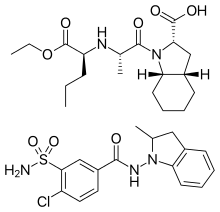Perindopril/indapamide
 | |
| Combination of | |
|---|---|
| Perindopril | ACE inhibitor |
| Indapamide | Thiazide-like diuretic |
| Clinical data | |
| Trade names | Preterax, Noliprel |
| Routes of administration | Oral (tablets) |
| ATC code | |
| Legal status | |
| Legal status |
|
| Identifiers | |
| PubChem CID | |
| ChemSpider | |
| (verify) | |
Perindopril/indapamide (marketed as Preterax and Noliprel) is a combination drug used for the treatment of essential hypertension.[1]
Form and composition
Each scored tablet contains 2 mg of perindopril tert-butylamine salt and 0.625 mg of indapamide.
Indication
Dosage and administration
One tablet daily, preferably to be taken in the morning and before a meal.
Elderly patients: Normal dosage.
Renal failure: Creatinine clearance (CrCl) >30 mL/min: no dosage modification. If CrCl <30 mL/min, treatment is contraindicated.
Pharmacological action
Using a fixed combination of an ACE inhibitor and a chlorosulfamoyl diuretic leads to additive synergy of the antihypertensive effects of the two constituents. Its pharmacological properties are derived from those of each of the components taken separately, in addition to those due to the additive synergistic action of the two constituents, when combined, on vascular endothelium, arteriolocapillary microcirculation, and the target organs of hypertension.
Contraindications
Absolute: Known allergy to perindopril, indapamide, or sulfonamides; history of Quincke's edema linked to previous ACE inhibitor therapy; end-stage renal disease; serious liver disorder; hyperkalemia; pregnancy; lactation. Relative: Combination therapy with lithium, potassium salts, potassium-sparing diuretics, and certain medicines which can cause heart rhythm disorders.
Side effects
Asthenia, dizziness, headache, mood swings and/or sleep disturbances, cramps, hypotension, allergic reactions, skin rashes, gastrointestinal disorders, dry cough, erectile dysfunctions, dry mouth, risk of dehydration in the elderly and in patients suffering from heart failure, sexual dysfunctions; changes in blood test results may occur.
Warnings
Immunosuppressed patients. Hemodialysis: risk of anaphylactoid reaction during hemodialysis with polyacrylonitrile membranes. Liver impairment.
Precautions
Disorders of electrolyte balance, diabetes, gout, hypotension, or strict sodium-free diets, heart or renal failure, atherosclerosis, renal artery stenosis, elderly.
Drug interactions
Not recommended: combinations with lithium, potassium-sparing diuretics, potassium (salts), antiarrhythmic drugs which can cause torsades de pointes, anesthetic drugs, cytostatics or immunosuppressive agents.
References
- ↑ D. Gareth Beevers; Gregory Y. H. Lip; Eoin T. O'Brien (26 November 2014). ABC of Hypertension. Wiley. pp. 83–. ISBN 978-1-118-59256-4.